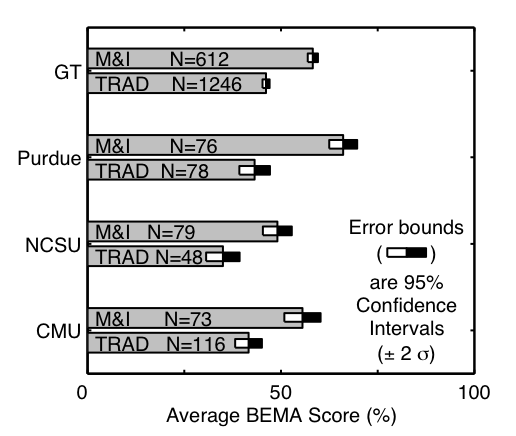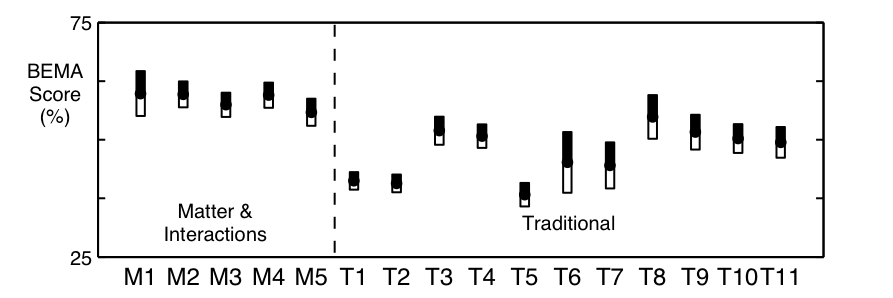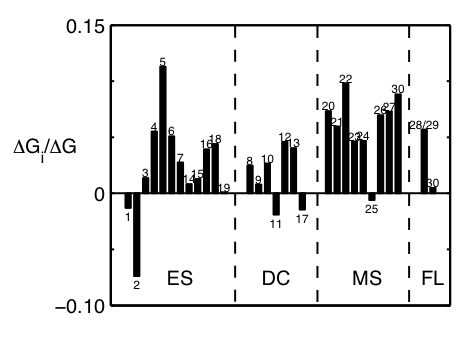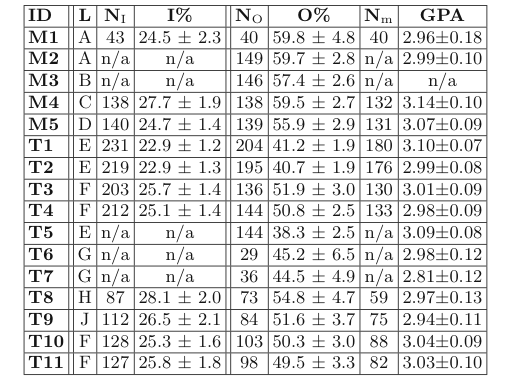The group has used the Brief Electricity and Magnetism Assessment (BEMA) to assess the qualitative understanding gained by introductory electromagnetism (E&M) students. The BEMA is a 30-item multiple choice test focusing on the core concepts of E&M. It contains items that are common to both courses including electrostatics, DC circuits, magnetostatics, and Faraday’s Law. This is assessment is widely considered to be a fair assessment of qualitative E&M knowledge, as it was designed with by M&I instructors with critiques by standard course instructors. This assessment is similar to the Conceptual Survey of Electrciy and Magnetism (CSEM), in fact common items appear on both tests. A copy of the assessment can be obtained by emailing Danny Caballero.
In performing these very large studies, students are often given the BEMA as a pre-assessment. This data combined with incoming GPAs form the set of data used to serve as a baseline for global measures of performance on the BEMA after instruction. A statistical test of these metrics: FCI pre-test and incoming GPA shows that the students entering each course can be considered to be from the same populations. That is, better than average (or worse than average) students are not drawn to one or other course.
Students in the M&I course outperform on the BEMA relative to their standard course (TRAD) cohorts. This performance is across all categories, even those for which the M&I spends less time covering in lecture and on homeworks (i.e., DC circuits). Because the design of this assessment was performed with the consult of traditional instructors and the because the assessment covers nearly all topics in the introductory E&M course, one can liken comparing BEMA scores to comparing qualitative E&M knowledge gained by students in each course. Work has been recently completed on this effort and has been published in PRST-PER. For more information on this work, please contact Danny Caballero.
There are several references to consider when discussing the BEMA. Those references are listed below:
- Ding, L. and Chabay, R. and Sherwood, B. and Beichner, R., Evaluating an electricity and magnetism assessment tool: Brief electricity and magnetism assessment, Physical Review Special Topics-Physics Education Research, vol. 2, pgs 010105, 2006
- Pollock, SJ, A Longitudinal Study of the Impact of Curriculum on Conceptual Understanding in E&M, 2007 Physics Education Research Conference, vol. 951, pgs. 172-175, 2007
- Pollock, SJ, Comparing student learning with multiple research-based conceptual surveys: CSEM and BEMA, 2008 Physics Education Research Conference, vol. 1064, pgs. 171-174, 2008
- Kohlmyer, M.A. and Caballero, M.D. and Catrambone, R. and Chabay, R.W. and Ding, L. and Haugan, M.P. and Marr, M.J. and Sherwood, B.A. and Schatz, M.F., A Tale of Two Curricula: The performance of two thousand students in introductory electromagnetism, Physical Review Special Topics-Physics Education Research, vol. 5, pgs 020105, 2009
Some of the results from this work appear below. For more information, please review our publication in PRST-PER.

Average post-instruction BEMA scores at four academic institutions – The average BEMA test scores are shown for students who have completed a one-semester E&M course with either the traditional (TRAD) or Matter & Interactions (M&I) curriculum. The number of students tested for each curriculum at each institution is indicated in the figure. The error bounds represent the 95% confidence intervals on the estimate of the average score.

Average BEMA scores by section at Georgia Tech – The average end-of-semester BEMA scores for 11 traditional (T#) and 5 M&I (M#) sections at GT are shown. The error bounds indicate 95% confidence intervals on the estimates of the average for each section. The number of students tested in a particular section is given by Nm in the table below.

Fractional difference in performance for E&M subtopics – The fractional difference in performance ΔGi/ΔG between M&I and traditional students at GT is shown for each question on the BEMA. Positive (negative) ΔGi/ΔG indicates superior performance by M&I (traditional) students. The numerical labels indicate the corresponding question number in order of appearance on the BEMA. The ΔGi/ΔG are grouped together into one of four topics: Electrostatics (ES), DC circuits (DC), Magnetostatics (MS), or Faraday’s Law and Induction (FL).

Georgia Tech BEMA test results are shown for five Matter & Interactions sections (M1-M5) and eleven traditional sections (T1-T11). Different lecturers are distinguished by a unique letter in column L. (Note that lecturer B in M3 was assisted by lecturer A.) The average BEMA score O for NO students completing the course is shown for all sections. Moreover, in those sections where data is available, the average BEMA score I for NI students entering the course are indicated. Nm is the number of students in a given section who took the BEMA both at the beginning and at the end of their E&M course. GPA is the incoming cumulative grade point average for students in a given section.
